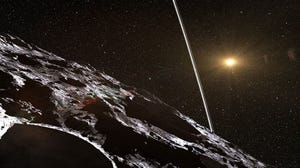
NASA Webb Telescope Zooms in on One of Solar System's Oddest Objects - CNET
Scientists using NASA’s new James Webb Space Telescope say they’ve been able to get a closer look at an asteroid that also hosts just the fifth ring system to be discovered in our solar system (the others circle Saturn, Jupiter, Uranus and Neptune).
Astronomers initially discovered the rings in 2013 while watching Chariklo occult, or pass in front of, a distant star. To their surprise, two other smaller objects also appeared to pass in front of the background star for an instant. These turned out to be two thin rings around Chariklo.
In October 2022, Pablo Santos-Sanz, from Instituto de Astrofísica de Andalucía in Spain, used Webb to watch Chariklo occult a star once again.
The above video of the observations shows the star Gaia DR3 6873519665992128512 at the center and Chariklo passing in front of it as mere pixels, but NASA says a careful analysis of dips in the star’s brightness shows the rings were clearly detected once again.
“As we delve deeper into the data… we also will explore the rings’ thickness, the sizes and colors of the ring particles and more,” Santos-Sanz explained in a statement.
So far, data suggests the rings could be made up of ice and other dark debris, probably the remnants of some ancient cosmic collision with the asteroid.
“Spectra from ground-based telescopes had hinted at this ice, but the exquisite quality of the Webb spectrum revealed the clear signature of crystalline ice for the first time,” Noemí Pinilla-Alonso, who led Webb’s spectroscopic observations of Chariklo, added.
Chariklo is a large asteroid at about 188 miles (302 kilometers) across, but it orbits the sun in the outer solar system, between Saturn and Uranus. Even with its size, it’s too far away for Webb to directly image the rings, making occultations the best way to study them for now.
Santos-Sanz is excited to see Webb’s advanced ability to study even small, distant objects in detail. Next up, he hopes to determine exactly how large the rings are and what they’re made up of.
“We hope to gain insight into why this small body even has rings at all,” he said, “and perhaps detect new fainter rings.”


